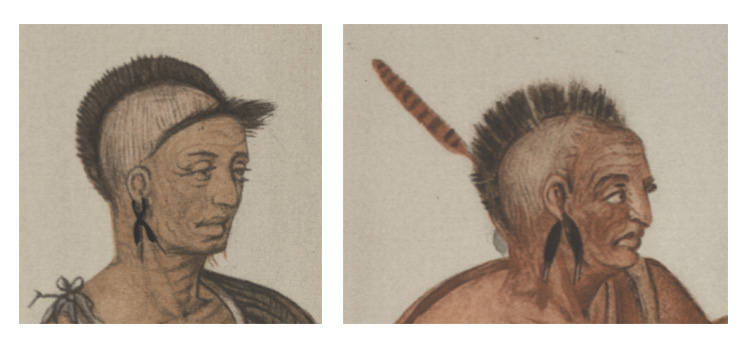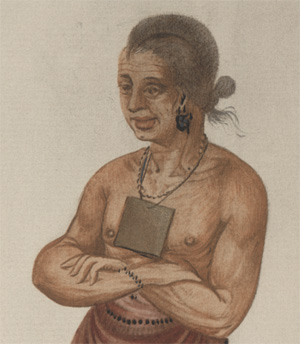
 |
| Overview | Site Context | Examine the Site | Timeline |
Paspahegh - Artifacts - CopperIt can be argued that Algonquians prized copper and copper ornaments above all other objects. Copper ornaments signified status in Algonquian society and were worn and perhaps controlled by werowances, who bestowed copper beads and pendants on accomplished warriors and used copper to decorate the carved representations of the god Okeus kept in their temples. In their first forays along the Carolina coast, the English quickly became aware of the value of this commodity to the Algonquians and brought cut pieces of sheet copper with them on subsequent voyages. European copper quickly flooded the market, however, and just a few years after the founding of Jamestown John Smith found Powhatan more willing to trade for corn than for copper. Sites occupied in the Late Woodland/Early Contact period thus offer the opportunity to study the changing value of copper in Algonquian society. For information on copper found at Jamestown in the Early Contact period, see Mallios and Emmett, "Demand, Supply, and Elasticity in the Copper Trade at Early Jamestown."View text of: "Demand, Supply, and Elasticity in the Copper Trade at Early Jamestown" by Seth Mallios and Shane Emmett (from The Journal of the Jamestown Rediscovery Center) |
|
| A total of 158 copper artifacts was recovered from 44JC308, including 152 tube beads, 3 sheet metal pendants, and 3 other types of beads made from both native and European copper. All but one of these artifacts are associated with the burials of at least nine individuals in three locations: Burial 9CH (a primary, single, extended burial), Burial 1 (secondary burials of three subadults and two adults), and Burial 12 (secondary burials of one subadult and three adults). | |
| The inclusion of copper ornaments in secondary burials, thought to be the typical mortuary treatment of "commoners," suggests that copper already may have been devalued by the time these burials were interred, or that Powhatan elites received a wider array of burial treatments than described by English observers. Of the 29 copper artifacts analyzed from Burials 1 and 12, 21 were of European manufacture. Tube beads were constructed by rolling rectangles of sheet copper and came in a variety of sizes from 8 cm to less than 1 cm long. Tube beads have been found circling the neck (as in the case of the adult male buried in Feature 9CH) and in clusters at the wrists of two individuals, where they were likely worn as a bracelets. Several paired tube beads were also found in the secondary burials that may be components of ear ornaments, such as the one worn in the White watercolor "Indian Man and Woman Eating" and "Indian Priest." |

Portions of the watercolor drawings "Indian Priest" (left) and "Indian Man and Woman Eating" (right) by John White (created 1585-1586). Licensed by the Trustees of the British Museum. © Copyright the British Museum. |
| The three pendants were flat and cut into triangular shapes from 2 to 6 cm on a side. Compositional analysis indicates that the two tested pendants were made from European copper. All were found in the neck and shoulder region of a single subadult of 1.5 to 2.5 years of age found in Ossuary 1. Several characteristics of two of the pendants suggest that they were made from a single square ornament approximately 2.2 cm on a side. The original ornament would have been hung from its corner, appearing as a diamond across the chest, unlike the large pendant shown in White's depiction of an "Indian Elder or Chief," which is pierced in the center of one side. The refashioning of a pendant made from European copper, the association of these objects with a subadult, and their inclusion in an ossuary all lend support to the notion that copper and copper pendants were not solely symbols of office at the time this individual was buried. Perhaps the initial square pendant was made from European-introduced copper to be worn by a Paspahegh elite in the traditional fashion, but lost its value once European copper became widespread and its distribution could no longer be controlled by Powhatan leaders. |
 A portion of the watercolor drawing "Indian Elder or Chief" by John White (created 1585-1586). Licensed by the Trustees of the British Museum. © Copyright the British Museum. |